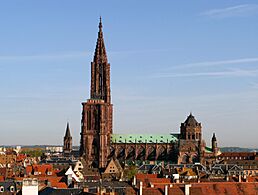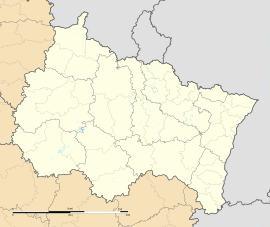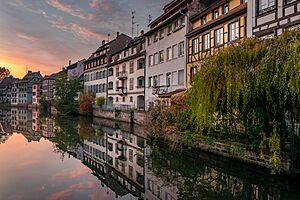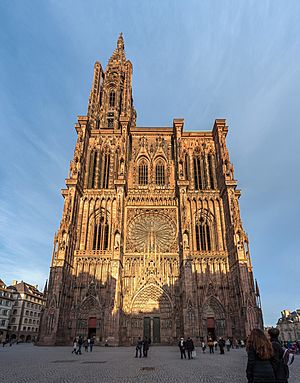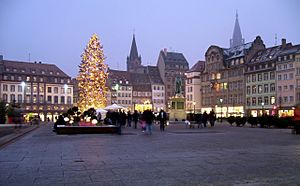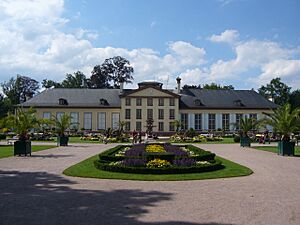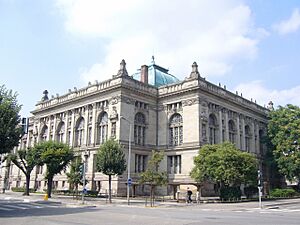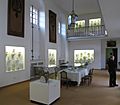Strasbourg facts for kids
Quick facts for kids
Strasbourg
|
|||
|---|---|---|---|
|
Prefecture and commune
|
|||
|
|
|||
|
|||
| Country | France | ||
| Region | Grand Est | ||
| Department | Bas-Rhin | ||
| Arrondissement | Strasbourg | ||
| Canton | 6 cantons | ||
| Intercommunality | Eurométropole de Strasbourg | ||
| Area
1
|
78.26 km2 (30.22 sq mi) | ||
| • Urban
(2018)
|
240.2 km2 (92.7 sq mi) | ||
| • Metro
(2019)
|
2,227.1 km2 (859.9 sq mi) | ||
| Population
(2021)
|
291,313 | ||
| • Rank | 8th in France | ||
| • Density | 3,722.37/km2 (9,640.9/sq mi) | ||
| • Urban
(2020)
|
484,217 | ||
| • Urban density | 2,015.9/km2 (5,221.1/sq mi) | ||
| • Metro
(2020)
|
860,744 | ||
| • Metro density | 386.486/km2 (1,000.995/sq mi) | ||
| Demonym(s) | Strasbourgeois (masculine) Strasbourgeoise (feminine) |
||
| Time zone | UTC+01:00 (CET) | ||
| • Summer (DST) | UTC+02:00 (CEST) | ||
| INSEE/Postal code |
67482 /
|
||
| Dialling codes | 0388, 0390, 0368 | ||
| Elevation | 132–151 m (433–495 ft) | ||
| 1 French Land Register data, which excludes lakes, ponds, glaciers > 1 km2 (0.386 sq mi or 247 acres) and river estuaries. | |||
Strasbourg is a major city in eastern France. It sits right on the border with Germany, in a historical area called Alsace. Strasbourg is the main city of the Grand Est region and the capital of the Bas-Rhin area. It is also the official home of the European Parliament.
Around 300,000 people live in Strasbourg. If you include the wider area, over 860,000 people call it home. Strasbourg is one of the most important cities for the European Union. It hosts many European groups, like the European Parliament and the Council of Europe. This makes it a key city for international decisions, even though it's not a country's capital.
Strasbourg's old city center, called the Grande Île (Grand Island), is a World Heritage Site recognized by UNESCO. This means it's a very special place worth protecting. The city has a mix of French and German cultures. It has been a bridge between these two countries for hundreds of years. The University of Strasbourg is one of the largest in France.
Strasbourg is also a big center for making things and for transportation. Its port on the Rhine River is one of the busiest in France.
Contents
- What Does the Name Strasbourg Mean?
- A Brief History of Strasbourg
- Strasbourg's Location and Weather
- Exploring Strasbourg's Districts
- Amazing Sights in Strasbourg
- People of Strasbourg
- Strasbourg's Culture and Events
- Learning in Strasbourg: Education and Libraries
- Getting Around Strasbourg: Transport
- Strasbourg's Role in Europe
- Sports in Strasbourg
- Famous People from Strasbourg
- Strasbourg's Twin Cities
- Images for kids
- See also
What Does the Name Strasbourg Mean?
The name Strasbourg has a long history. Before the 5th century AD, the city was known as Argantorati. This was a Celtic name that meant "fortified place by silver" or "precious metal."
Later, the city got a new name, which became Strasbourg. This name comes from Germanic languages. It means "town at the crossing of roads." The "Stras-" part is like the English word "street." The "-bourg" part is like the English word "borough," meaning a fortress or town.
An old writer named Gregory of Tours was the first to mention this name change. He wrote about it around the year 590.
A Brief History of Strasbourg
Strasbourg has a very long and interesting history. The Roman camp of Argentoratum was first mentioned in 12 BCE. The city celebrated its 2,000th birthday in 1988!
Who Ruled Strasbourg?
From 362 to 1262, bishops ruled Strasbourg. But in 1262, the people fought back and won their freedom. Strasbourg then became a "free imperial city." This meant it was independent within the Holy Roman Empire.
In 1681, King Louis XIV's army took over Alsace, and Strasbourg became part of France. But this changed again in 1871 after the Franco-Prussian War. Strasbourg became German once more. It stayed German until the end of World War I in 1918, when it returned to France.
During World War II, the German army captured Strasbourg in 1940. It was freed by the French army in November 1944. Since then, it has been a French city. In 2016, Strasbourg became the capital of the new Grand Est region.
Important Moments in Strasbourg's History
Strasbourg played a big part in the Protestant Reformation. Many important thinkers like John Calvin lived here. It was also one of the first places where printing started, thanks to people like Johannes Gutenberg.
Some sad times in the city's history include the Strasbourg massacre in 1349 and the Dancing plague of 1518. But there were also many good things. The University of Strasbourg was started in 1538. In 1605, the world's first newspaper was printed here by Johann Carolus. The French national anthem, La Marseillaise, was first played in Strasbourg in 1792.
Since 1949, Strasbourg has been home to many European organizations. This shows its role in bringing countries together.
Strasbourg's Location and Weather
Where is Strasbourg Located?
Strasbourg is on the eastern edge of France, right next to Germany. The Rhine River forms this border. The old part of Strasbourg is on an island called the Grande Île, in the Ill River. The Ill River flows into the Rhine.
The city is in a flat area called the Upper Rhine Plain. Mountains like the Vosges Mountains are to the west, and the Black Forest is to the east. This area is a major route for travel by river, road, and train. Strasbourg is about 397 kilometers (247 miles) east of Paris.
What is Strasbourg's Climate Like?
Strasbourg has an oceanic climate, which means it has warm, sunny summers and cool, cloudy winters.
The highest temperature ever recorded was 38.9°C (102.0°F) in July 2019. The lowest was -23.4°C (-10.1°F) in December 1938.
Because it's in the Rhine valley, the city is protected by mountains. This means the air doesn't move around much. In the past, this led to air pollution. But now, with less heavy industry and better traffic rules, the air quality has improved.
Exploring Strasbourg's Districts
Strasbourg is divided into several different areas, each with its own feel:
- Bourse, Esplanade, Krutenau
- Centre Ville (Downtown Strasbourg)
- Gare, Tribunal (Central Station, Court)
- Conseil des XV, Orangerie
- Cronenbourg
- Hautepierre, Poteries
- Koenigshoffen
- Montagne-Verte (Green Hill)
- Elsau
- Meinau
- Neudorf-Musau
- Neuhof 1 (including Ganzau)
- Neuhof 2
- Robertsau
- Port du Rhin (Rhine's Harbor)
Amazing Sights in Strasbourg

Strasbourg's Unique Architecture
Strasbourg is famous for its beautiful Cathedral. It's a huge Gothic building made of sandstone, with a famous astronomical clock inside. The city also has many medieval buildings with black and white timber frames, especially in the Petite France area. This area is known as the "tanners' district" and sits along the Ill River. The famous Maison Kammerzell is also here.
Some notable medieval streets include Rue Mercière and Rue des Dentelles. Important medieval squares are Place de la Cathédrale and Place Benjamin Zix.
Besides the Cathedral, Strasbourg has other old churches that survived wars. The Église Saint-Thomas has a Silbermann organ that Wolfgang Amadeus Mozart once played. The Église protestante Saint-Pierre-le-Jeune has parts from the 7th century.
The German Renaissance period also left its mark, like the building that is now the Chamber of Commerce. The French Baroque and Classicism styles can be seen in grand palaces like the Palais Rohan, which now holds three museums. The Strasbourg Opera House is a beautiful example of Neoclassicism.
Strasbourg also has a large German district called the Neustadt. This area has impressive buildings from the time when Germany ruled the city. The former imperial palace, Palais du Rhin, is a great example of this grand style.
The city has many bridges. The medieval Ponts Couverts (Covered Bridges) are famous, even though they aren't covered anymore. Next to them is the Barrage Vauban, a 17th-century fortification.
The largest square in the city center is the Place Kléber. It's named after General Jean Baptiste Kléber, who was born in Strasbourg.
Parks and Green Spaces
Strasbourg has many lovely parks. The Parc de l'Orangerie was designed for Joséphine de Beauharnais. It has beautiful gardens, a castle, and a small zoo. The Parc de la Citadelle is built around parts of a 17th-century fortress.
The Jardin botanique de l'Université de Strasbourg (botanical garden) was created in 1881. The Jardin des deux Rives is a huge park that crosses the Rhine River, connecting Strasbourg with the German town of Kehl.
Strasbourg's Museums
Strasbourg has many museums that show off its art, history, and culture.
Art Museums
- The Musée des Beaux-Arts has paintings by famous artists like Francisco Goya and Peter Paul Rubens.
- The Musée de l'Œuvre Notre-Dame is next to the cathedral. It has medieval art, including original sculptures and stained glass from the cathedral.
- The Musée d'Art moderne et contemporain is one of the biggest modern art museums in France.
- The Musée des Arts décoratifs is in the beautiful Rohan Palace. It shows off furniture and china from the 18th century.
- The Musée Tomi Ungerer/Centre international de l'illustration displays original works by the artist Tomi Ungerer and his collection of old toys.
Other Interesting Museums
- The Musée archéologique shows items from ancient times in the region, including Roman and Celtic artifacts.
- The Musée alsacien focuses on the traditional daily life of Alsace.
- Le Vaisseau ("The vessel") is a science and technology center especially for children.
- The Musée historique tells the story of the city. It has many old items, including a horn that was blown in medieval times to tell Jewish people to leave the city at night.
- The Musée vodou is a unique museum about Haitian Vodou, located in an old water tower.
University Museums
The Université de Strasbourg also has several public museums with scientific collections:
- The Musée zoologique is famous for its bird collection.
- The Gypsothèque has a large collection of plaster casts of famous sculptures.
- The Musée de Sismologie et Magnétisme terrestre shows old instruments for measuring earthquakes and magnetism.
- The Musée Pasteur has medical curiosities.
- The Musée d'Égyptologie has items from ancient Egypt and Sudan.
People of Strasbourg
Strasbourg has a growing population. On January 1, 2021, about 291,313 people lived in the city itself. The wider metropolitan area had over 853,000 people in 2019. The Eurodistrict, which includes parts of Germany, had about 1,000,000 people in 2022.
In the Middle Ages, Strasbourg was a very important town. In 1444, it had about 20,000 people, which was a lot for that time.
Population Growth in Strasbourg
| Historical population | ||||||||||||||||||||||||||||||||||||||||||||||||||||||||||||||||||||||||||||||||||||||||||||||||||||||||||||||||||||||
|---|---|---|---|---|---|---|---|---|---|---|---|---|---|---|---|---|---|---|---|---|---|---|---|---|---|---|---|---|---|---|---|---|---|---|---|---|---|---|---|---|---|---|---|---|---|---|---|---|---|---|---|---|---|---|---|---|---|---|---|---|---|---|---|---|---|---|---|---|---|---|---|---|---|---|---|---|---|---|---|---|---|---|---|---|---|---|---|---|---|---|---|---|---|---|---|---|---|---|---|---|---|---|---|---|---|---|---|---|---|---|---|---|---|---|---|---|---|---|
|
|
|||||||||||||||||||||||||||||||||||||||||||||||||||||||||||||||||||||||||||||||||||||||||||||||||||||||||||||||||||||
| Source: EHESS and INSEE (1968-2017) | ||||||||||||||||||||||||||||||||||||||||||||||||||||||||||||||||||||||||||||||||||||||||||||||||||||||||||||||||||||||

How Old Are Strasbourg's Residents?
| 2012 | % | 2007 | % | |
|---|---|---|---|---|
| Total population | 274,394 | 100 | 272,123 | 100 |
| 0–14 years | 47,473 | 17.3 | 46,263 | 17.0 |
| 15–29 years | 77,719 | 28.3 | 78,291 | 28.8 |
| 30–44 years | 54,514 | 19.9 | 54,850 | 20.2 |
| 45–59 years | 45,436 | 16.6 | 47,236 | 17.4 |
| 60–74 years | 30,321 | 11.1 | 27,060 | 9.9 |
| 75+ years | 18,931 | 6.9 | 18,424 | 6.8 |
Strasbourg's Culture and Events
Strasbourg is a hub for music and theater. It has one of the oldest orchestras in Western Europe, the Orchestre philharmonique de Strasbourg. It's also home to the Opéra national du Rhin (opera house) and the Théâtre national de Strasbourg (national theater).
Festivals and Events in Strasbourg
- Musica: An international festival for modern classical music in the autumn.
- Festival international de Strasbourg: A summer festival for classical music and jazz.
- Strasbourg European Fantastic Film Festival: A film festival for science fiction, horror, and fantasy movies.
- Strasbulles: The city's yearly comic book convention.
- Christkindelsmärik: A famous Christmas market that started in 1570. It runs from late November through December.
Learning in Strasbourg: Education and Libraries
Universities and Higher Education
Strasbourg has a long history of excellent education. It has been a place where French and German ideas meet. Many famous people studied law here, like Johann Wolfgang von Goethe. The city's university has won 19 Nobel Prizes, making it a very important university outside of Paris.
In 2009, three universities in Strasbourg merged to form the Université de Strasbourg. It has many different schools, including:
- Sciences Po Strasbourg: For political science and international studies.
- The EMS (EM Strasbourg Business School): The university's business school.
- The INSA (Institut national des sciences appliquées): An engineering school.
- The ENA (École nationale d'administration): This school trains many of France's top public officials.
Other colleges in Strasbourg include American universities like University of Syracuse and Centre College. There's also a famous art school called HEAR and the International Space University.
Libraries in Strasbourg
The Bibliothèque nationale et universitaire (BNU) is the second-largest library in France. It has over 3 million books! It was started after the old city library was destroyed in 1870. It's special because it serves both students and the whole country.
The city's public library system, Bibliothèque municipale de Strasbourg (BMS), has ten smaller libraries. A very large new library, the Médiathèque André Malraux, opened in 2008. It is the biggest in Eastern France.
Strasbourg was one of the first places to print books in Europe. Because of this, its libraries used to have many incunabula (books printed before 1500). After the old library was destroyed, new collections were started. Today, Strasbourg's libraries still have a good number of these rare old books.
Getting Around Strasbourg: Transport
Strasbourg is well-connected by train. The main station, Gare de Strasbourg, has trains going to Germany, Paris, and Basel. The city is also connected to France's high-speed TGV train network, making travel much faster.
Strasbourg has its own airport with flights to many places in Europe and North Africa. A train connects the airport to the city's main station.
Public Transport in Strasbourg
The city has a modern Strasbourg tramway system, which opened in 1994. It has 6 lines and is run by the Compagnie des Transports Strasbourgeois (CTS). The CTS also runs a bus network that works with the trams.
Strasbourg is very bike-friendly, with over 500 kilometers (310 miles) of bike paths. The CTS also has a cheap bike-sharing program called Vélhop.
Being on the Ill and Rhine rivers, Strasbourg has always been important for river travel. Several canals are still used today, and the Port autonome de Strasbourg is very active. Many tourists enjoy boat trips inside the city.
The city center is designed to be easy to walk and bike in. Cars are limited in some areas, making it safer and more pleasant for people on foot or bikes.
How People Use Public Transport
On average, people in Strasbourg spend about 52 minutes commuting on public transport on weekdays. About 7% of travelers spend more than 2 hours commuting each day. People usually wait about 9 minutes for public transport. The average distance traveled in one trip is about 3.9 kilometers (2.4 miles).
Strasbourg's Role in Europe
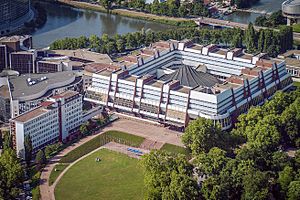
European Institutions in Strasbourg
Strasbourg is home to more than twenty international organizations. The most famous are the Council of Europe and the European Parliament. Strasbourg is seen as the "legislative and democratic capital" of the European Union. This means it's where laws are discussed and decided.
Some of the important organizations in Strasbourg include:
- Central Commission for Navigation on the Rhine (since 1920)
- Council of Europe (since 1949)
- European Parliament (since 1952)
- European Ombudsman (who helps people with problems with EU institutions)
- Eurocorps headquarters (a European army corps)
- Arte (a Franco-German TV channel)
- International Institute of Human Rights
The Eurodistrict
France and Germany have created a special area called the Strasbourg-Ortenau Eurodistrict. This area crosses the Rhine River and includes Strasbourg and the German Ortenau district. They work together on some common projects and administration. It started in 2005.
Sports in Strasbourg
Strasbourg has several sports teams:
- Racing Club de Strasbourg Alsace (football/soccer)
- SIG Strasbourg (basketball)
- Étoile Noire (ice hockey)
The city also hosts the Internationaux de Strasbourg, an important women's tennis tournament. In 2006, Strasbourg was the starting point for the 2006 Tour de France, a famous bicycle race.
Famous People from Strasbourg
Many notable people were born in or lived in Strasbourg:
- Johannes Gutenberg: A pioneer of printing.
- Jean Baptiste Kléber: A famous general.
- Marie Tussaud: Known for her wax museum.
- Johann Wolfgang Goethe: A famous German writer.
- Louis Pasteur: A famous scientist.
- Albert Schweitzer: A Nobel Peace Prize winner.
- Marcel Marceau: A world-famous mime artist.
- Tomi Ungerer: A well-known illustrator.
- Arsène Wenger: A famous football manager.
- Matt Pokora: A popular singer.
Strasbourg's Twin Cities
Strasbourg is "twinned" with several cities around the world. This means they have special friendly relationships and often work together on projects.
 Boston, United States (since 1960)
Boston, United States (since 1960) Leicester, United Kingdom (since 1960)
Leicester, United Kingdom (since 1960) Stuttgart, Germany (since 1962)
Stuttgart, Germany (since 1962) Dresden, Germany (since 1990)
Dresden, Germany (since 1990) Ramat Gan, Israel (since 1991)
Ramat Gan, Israel (since 1991)
Strasbourg also has cooperation agreements with other cities, including:
 Jacmel, Haiti (since 1991)
Jacmel, Haiti (since 1991) Fez, Morocco (since 1999)
Fez, Morocco (since 1999) Douala, Cameroon (since 2005)
Douala, Cameroon (since 2005) Vologda, Russia (since 2009)
Vologda, Russia (since 2009) Oran, Algeria (since 2015)
Oran, Algeria (since 2015) Kairouan, Tunisia (since 2015)
Kairouan, Tunisia (since 2015) Moscow, Russia (since 2016)
Moscow, Russia (since 2016) Kampala, Uganda (since 2018)
Kampala, Uganda (since 2018) Kagoshima, Japan (since 2019)
Kagoshima, Japan (since 2019)
Images for kids
-
Sigismund, Holy Roman Emperor visiting Strasbourg in 1414
-
View of the Ill River with Église Saint-Thomas
-
The baroque organ of the Église Saint-Thomas
See also
 In Spanish: Estrasburgo para niños
In Spanish: Estrasburgo para niños


